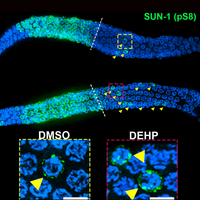Login
Subscribechromosome

Male and Female Stem Cells Derived from One Donor in Scientific First
Dan Robitzski | Dec 22, 2022 | 3 min read
Studying otherwise identical XY, XX, X0, and XXY pluripotent stem cells will allow researchers to investigate sex-based differences in greater depth.

The Long and Winding Road to Eukaryotic Cells
Amanda Heidt | Oct 17, 2022 | 10+ min read
Despite recent advances in the study of eukaryogenesis, much remains unresolved about the origin and evolution of the most complex domain of life.

Investigating Genetic and Epigenetic Landscapes with Long-Read Sequencing
The Scientist Creative Services Team in collaboration with Oxford Nanopore | 1 min read
Matthew Naish will discuss what he learned about Arabidopsis thaliana centromeres from long-read sequencing experiments.

Infographic: Evolutionary Leaps Leading to Modern Eukaryotes
Amanda Heidt | Oct 17, 2022 | 2 min read
A lot happened in the hundreds of millions years separating the first and last eukaryotic common ancestors, but when and how most features arose remains a mystery.

Infographic: The Sequencing and Assembly of the Human Genome
Brianna Chrisman and Jordan Eizenga | Sep 1, 2022 | 5 min read
With ever-advancing genetic technologies, researchers continue to document the genetic code of the human species.

Scaling BAC on Time and Sample
The Scientist Creative Services Team in collaboration with Agilent Technologies | 3 min read
A new and simplified quality control method confirms the cloning of both small and large inserts in bacterial artificial chromosomes (BACs) with significantly less time and sample.

Large Scientific Collaborations Aim to Complete Human Genome
Brianna Chrisman and Jordan Eizenga | Sep 1, 2022 | 10+ min read
Thirty years out from the start of the Human Genome Project, researchers have finally finished sequencing the full 3 billion bases of a person’s genetic code. But even a complete reference genome has its shortcomings.

Researchers Fuse Mouse Chromosomes in Scientific First
Natalia Mesa, PhD | Aug 25, 2022 | 4 min read
The findings will likely help elucidate the effects of chromosome fusions, which can cause disease but have also contributed to evolution.

Bridging Disciplines to Study CRISPR-Induced Chromosome Destabilization
Aparna Nathan, PhD | Apr 8, 2022 | 4 min read
A collaboration between friends led to a cautionary finding about CRISPR’s effect on cells.

How Chaos in Chromosomes Helps Drive Cancer Spread
Samuel F. Bakhoum | Mar 1, 2022 | 10+ min read
A new link between inflammation and rampant chromosomal abnormalities reveals novel strategies to treat diverse malignancies.

Infographic: Chromosome Errors Cause Micronuclei and Drive Cancer
Samuel F. Bakhoum | Mar 1, 2022 | 2 min read
When micronuclei rupture, chromosomes break, recombine, and form circles, causing inflammation and promoting carcinogenic growth.

Chromosomal Rearrangement Linked to Less Mobile Quail
Chloe Tenn | Dec 7, 2021 | 5 min read
The Scientist interviews evolutionary biologist Carles Vilà about how a large genomic inversion detected in common quail affects the birds’ physical characteristics and migratory behaviors.

Fish Species’ Y Chromosomes Diverged Even Without Recombination
Catherine Offord | Sep 1, 2021 | 2 min read
Researchers discover surprisingly high levels of genetic diversity among the colorful male morphs of a freshwater fish.

Cell Biologist Angelika Amon Dies at 53
Max Kozlov | Nov 4, 2020 | 3 min read
A “larger than life personality,” Amon devoted her career to studying the cell cycle and aneuploidy. Her research has shaped the field of cancer biology.

Michelle Gray Tracks Huntington’s in Different Brain Cells
Amanda Heidt | Oct 1, 2020 | 3 min read
The University of Alabama at Birmingham neuroscientist aims to determine which cells are most important in prompting the disease’s initiation and progression.

CRISPR Gene Editing Prompts Chaos in DNA of Human Embryos
Amanda Heidt | Jun 26, 2020 | 3 min read
Three studies identify unintended consequences of gene editing in human embryos, including large deletions and reshuffling of DNA.

Image of the Day: Impaired Meiosis
Amy Schleunes | Feb 7, 2020 | 1 min read
A phthalate commonly found in shampoos, cosmetics, and cleaning products disrupts reproduction in worms.

Image of the Day: Chromatin Forest
Emily Makowski | Jan 14, 2020 | 1 min read
The DNA-protein complex has branches that fold back on themselves.

Infographic: Building an Artificial Chromosome
Ruth Williams | Nov 1, 2019 | 1 min read
Integrating a specialized histone into large segments of transgenic DNA enables centromere formation.
